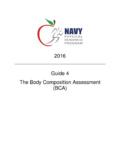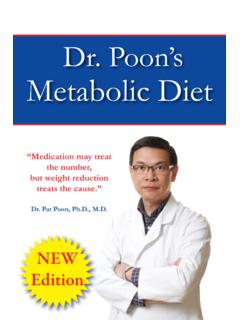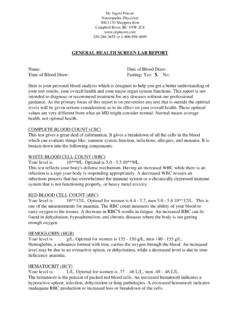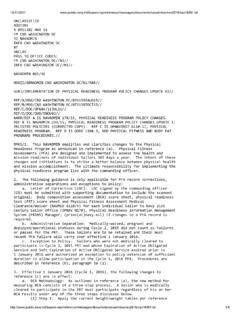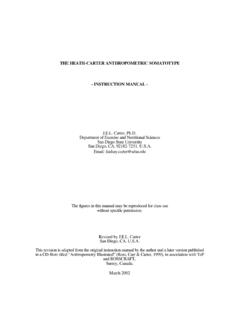Transcription of Revista Brasileira de Ciência Avícola Oil and Fat in ...
1 Brazilian Journal of Poultry ScienceRevista Brasileira de Ci ncia Av cola ISSN 1516-635X Jul - Sep 2005 / / / 129 - 141129 Oil and Fat in Broiler NutritionNelson Carneiro Bai oEscola de Veterin ria - UFMGD epartamento de ZootecniaAvenida Ant nio Carlos, Belo Horizonte, MG, BrasilE-mail: AddressKeywordsBai o NCLara LJCD epartamento de ZootecniaEscola de Veterin ria da UFMGA uthor(s)Arrived: may / 2005 Approved: july / 2005 ABSTRACTThe terms fat and oil refer to triglycerides of several profiles offatty acids. Fatty acids that are not bound to other organic componentsas glycerol are the so-called free fatty acids.
2 Lipids constitute the mainenergetic source for animals and they have the highest caloric valueamong all the nutrients. Linoleic acid is the only fatty acid whose dieteticrequirement has been demonstrated. Besides supplying energy, theaddition of fat to animal diets improves the absorption of fat-solublevitamins, decreases pulverulence, increases diet palatability, and theefficiency of utilization of the consumed energy. Furthermore, it reducesthe rate of food passage through the gastrointestinal tract, which allowsa better absorption of all nutrients present in the diet.
3 The energeticvalue of oils and fats depend on the following: the length of the carbonicchain, the number of double bonds, the presence or absence of esterbonds (triglycerides or free fatty acids), the specific arrangements ofthe saturated and unsaturated fatty acids on the glycerol backbone,the composition of the free fatty acid, the composition of the diet, thequantity and the type of the triglycerides supplemented in the diet, theintestinal flora, the sex and the age of the birds. In birds, body fat compositionis similar to the composition of the fat from the diet.
4 The apparent digestibilityof unsaturated fats is high in the first days of life of birds, whereas apparentdigestibility of saturated fats is low. The quantity of oils or fats is assessedby the following methods: titration, moisture, impurities, unsaponifiable,saponification value, percentage of fat, percentage of free fatty acids/acidity and the profile of fatty acids. The methods initial peroxide value,active oxygen method, osi, iodine value, and analysis of the thiobarbituricacid (TBARS) are specific to evaluate the oxidative stability. Consideringdiets with the same nutritive values, birds fed with rations containing oilpresent better performance than birds fed no oil.
5 Moreover, the use ofoil or fat in diets for broilers may change both the composition and thequality of the term fat (animal or vegetal) is used as a synonym for lipid inthe human food as well as in the ingredients for animal nutrition. Theaddition of fat to diets, besides supplying energy, improves the absorptionof fat-soluble vitamins, diminishes the pulverulence, increases thepalatability of the rations, and increases the efficiency of the consumedenergy (lower caloric increment). Furthermore, it reduces the passagerate of the digesta in the gastrointestinal tract, which allows a betterabsorption of all nutrients present in the terms fat and oil refer to triglycerides of several profiles of fattyacids.
6 The fats and oils are esters of glycerol; the former are solid,whereas the latter are liquid at room nutrition, fat, lipids, o NC, Lara LJCOil and Fat in Broiler Nutrition130 Lipids constitute the main energy reserve of animalsand it has the highest caloric value among all carbon atoms of the fatty acids are chemically morereduced than carbon atoms found in sugar; therefore,the oxidation of triglycerides releases more than twiceas much energy as carbohydrates. The deposition of 1g of energy from carbohydrates or protein by an animalrequires higher quantities of these nutrients incomparison to the deposition of 1 g of energy fromfat.
7 Moreover, carbohydrate and protein reserveswould be larger in function of the polar characteristicof theses substances, which would include water inthese deposits (Lehninger et al., 2000). Consideringdiets with similar nutritive value, chickens fed rationscontaining oil showed better performance than birdsfed diets without oil inclusion (Moura, 2003).Definition of lipidsLipids are substances soluble in non-polar organicsolvents (chloroform and ether) and insoluble in water,which can be divided into four categories: simple,compound, derived and lipids are esters of fatty acids and certainalcohols, particularly glycerol and cholesterol.
8 Thesecan be divided into three classes: triglycerides, steroids,and waxes. Triglycerides are constituted by glycerolesterified with three fatty acids and represent morethan 90% of the foods used in animal feeding. Steroidsare lipids that cannot be saponified, which means thatheating in the presence of alkalis does not hydrolyzethem; therefore soap is not produced from their fattyacids. Sterols are the most abundant steroids, andcholesterol is the main sterol of animal tissues (Ferreira,1999). Waxes are esters of fatty acids with long-chainalcohols and constitute the natural protecting coverageof leaves, stems, insects, skin, feathers, hairs and alsothe structural material of beehives.
9 They have nonutritional value, since they are hydrophobic and cannotbe degraded by the digestive enzymes of superioranimals (Ferreira, 1999).Compound lipids are esters of glycerol that containtwo fatty acids plus another chemical group such ascholine or serine. The most important groups are thephospholipids, which contain phosphate in theirstructures, whereas glycolipids have one carbohydratereplacing a fatty acid, and lipoproteins, whichconstitute the principal means by which lipids aretransported in the blood (Leeson & Summers, 2001).Derived lipids include substances with fatty acid,glycerol and with other alcohols that derive from simpleand compound lipids after hydrolysis (Ferreira, 1999).
10 Terpenoids are characterized by a repeating unity,which is the isopropene. This group includes thecarotenoids, xantophylls, tocopherols and vitamins Aand K (Ferreira, 1999).According to Fats (1985), the so-called free fattyacids are not linked to another organic component asthe glycerol. The free fatty acids comprise a smallfraction of total lipids in natural physical and chemical properties of lipids aredetermined by the composition of their fatty acids, andthe length and saturation degree of the carbonic term saturated means the absence of double bonds,whereas unsaturated indicates the presence of one ormore double bonds.











